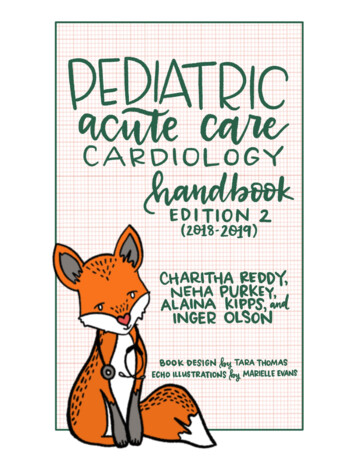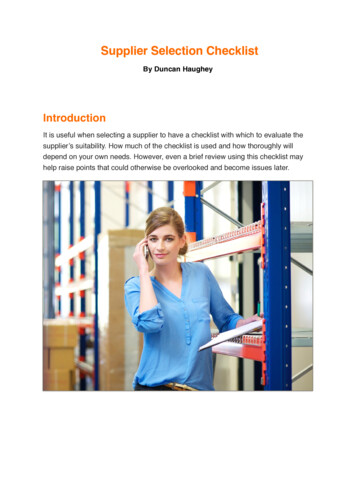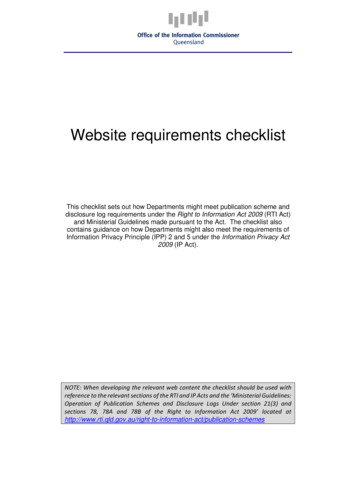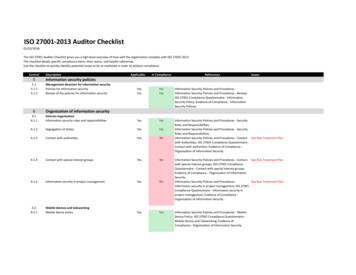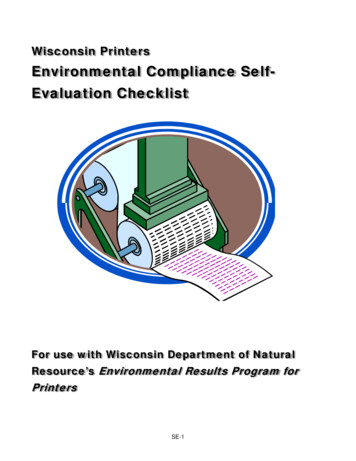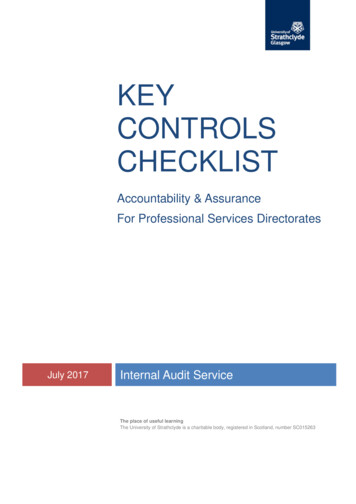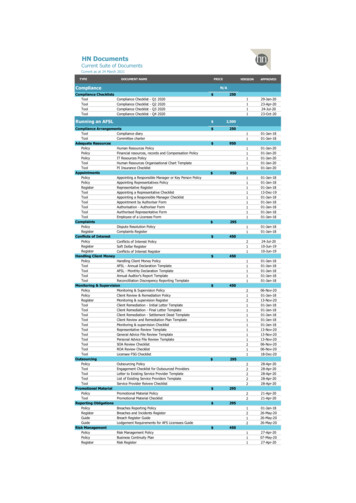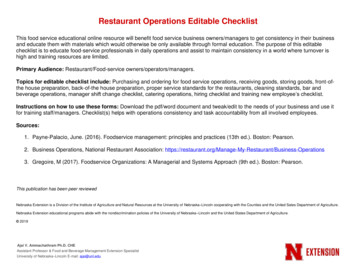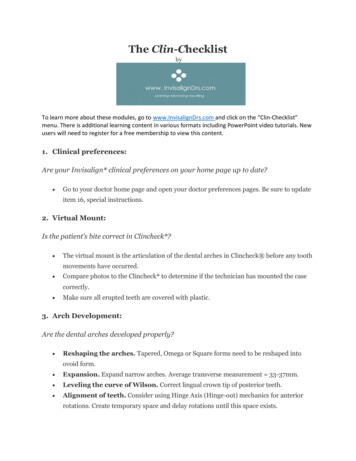
Transcription
The Clin-ChecklistbyTo learn more about these modules, go to www.InvisalignDrs.com and click on the “Clin-Checklist”menu. There is additional learning content in various formats including PowerPoint video tutorials. Newusers will need to register for a free membership to view this content.1. Clinical preferences:Are your Invisalign clinical preferences on your home page up to date? Go to your doctor home page and open your doctor preferences pages. Be sure to updateitem 16, special instructions.2. Virtual Mount:Is the patient’s bite correct in Clincheck ? The virtual mount is the articulation of the dental arches in Clincheck before any toothmovements have occurred. Compare photos to the Clincheck to determine if the technician has mounted the casecorrectly. Make sure all erupted teeth are covered with plastic.3. Arch Development:Are the dental arches developed properly? Reshaping the arches. Tapered, Omega or Square forms need to be reshaped intoovoid form. Expansion. Expand narrow arches. Average transverse measurement 33-37mm. Leveling the curve of Wilson. Correct lingual crown tip of posterior teeth. Alignment of teeth. Consider using Hinge Axis (Hinge-out) mechanics for anteriorrotations. Create temporary space and delay rotations until this space exists.
Leveling the Curve of Spee. Overtreat anterior if intrusion 2mm. Add posteriorattachments to anchor the aligners.4. Overbite:Is this a deep bite (Overbite 2mm) case?4 possible components for deep bite correction. Leveling the Curve of Wilson: Upright lingually tipped posterior teeth. Leveling the Curve of Spee: Overtreat anterior intrusion 2mm. Posterior aligner anchorage to prevent slippage during anterior intrusion. AddHorizontal-Beveled-Incisal (Occlusal) attachments to 2nd premolar or 1st molars. Proclination of retroclined anterior teeth. Correct anterior lingual crown tip.5. Overjet:Does the overjet in Clincheck need modification?Incorporate 1-2mm of overjet in Clincheck This will lower the risk of developing premature anterior contacts and a posterior openbite.If IPR is added for the sole reason to create this overjet, add the IPR in the later stages.Then you assess the patient’s occlusion and decide if the IPR is needed.6. Class II cases:Does your patient have a class II malocclusion?Treatment goals for non-growing class II cases: Improve but not necessarily fully correct the molar and cuspid AP discrepancy.Create arch space for alignment, midline correction, and anterior retraction.Improve function.Treatment goals for growing class II cases: Attempt to fully correct the molar and cuspid AP discrepancy.Create arch space for alignment, midline correction, and anterior retraction.Improve function.
Protocol options available for class II treatment: Distalization (sequential): Maximum distalization 4 mm. Perform mesial-outrotation of the upper 1st molars. Extract upper wisdom teeth present. Use class IIelastics. Be prepared for long treatment times.IPR: Develop the arches before adding any IPR. Consider posterior IPR beforeadding distalization. Posterior IPR will improve the cuspid relationship.Elastics: Class II elastics are mandatory for distalization cases. They provideanchorage which will maximize the effect of the distalization. Full-time use asindicated during the distalization process.Bite Ramps: Use virtual bite ramps when performing distalization. If excessiveoverjet prevents ramps from being used with teeth 7 – 10, use cuspid ramps.Posterior disocclusion while the aligners are being worn can assist with posteriortooth movements.7. Root Torque:Does this case need additional root torque in Clincheck ? Add additional lingual torque in cases where there is noticeable retroclination (lingualcrown tip) of anterior teeth. Request constant lingual root torque in spacing cases where anterior teeth are beingretracted. Request additional labial root torque in cases where anterior are being proclined.8. Spacing cases:Do you want to close or redistribute the space? Determine the reason for the spacing. Tooth size discrepancy, Proclined or flaredanterior teeth, Missing teeth or a combination of these.Decide how you are going to close the space. Translation or RetractionInclude virtual C-chain aligners at the end. Apply these even if spaces appearclosed.Retention: Order Vivera retainers from the stage after chains have been used.This incorporates over correction in your retainers. Carefully check for slight
anterior interferences and perform equilibration as needed. Stress retainercompliance with patient. Consider bonded lingual retainers in addition to Vivera.9. Interproximal Reduction (IPR):Is IPR needed? Anterior IPR or posterior IPR? Stage IPR when teeth are aligned.Avoid IPR in sites where there are Emax or Zirconia crowns.IPR may be used to reduce black triangles.Add Virtual C Chains to close residual anterior spaces. 10.AttachmentsDo you need to change, remove or add attachments? Use Rectangular-Horizontal-Beveled-Gingival attachments for extrusions.Use Rectangular-Horizontal-Beveled-Incisal attachments for intrusion oranchorage in deep bite cases.Use Vertical-Beveled attachments for rotations, crown tip (mesial or distal), andtranslation.Upper laterals: add attachments to improve trackingAvoid attachments on crowned teeth if possible.Consider using larger attachments.11. Tooth Movements Check tooth movements before approving a ClinCheck. Use 3D controls to checkand “click down” movement values if possible. This is especially recommendedfor posterior tooth movements that move the root apices.Here are general posterior movement guidelines we recommend.o Posterior Intrusion/extrusion .2mmoooPosterior translation B/L 2.0mmPosterior translation M/D 2.0mmPosterior rotations: reduce the degree of rotation as much as possiblewithout compromising outcome. There is no target value, however
ooolowering any movement values can increase the outcome predictability.Rotations do not reposition root apices and therefore are not as difficult.Posterior crown angulation change (M/D) 2 degrees.Posterior root torque (B/L) 2 degrees.Posterior crown tip (B/L). We recommend using crown tip movements tochange the buccal-lingual angulation of teeth whenever possible. Thismovement is predictable because the root apex (apices) is not moved.Crown tip movements over 2 degrees are ok. Note that the 3D tool bardisplays the change in B/L angulation but does not distinguish roottorque from crown tip. Hopefully they will correct this with a futureupdate.12. Bite rampsDo you want to add bite ramps? When there is anterior intrusion and/or posterior extrusion.When treating a posterior x-bite and/or posterior expansion.When performing molar distalization for class II treatment, consider includingcuspid ramps on 6 and 11. This prevents the patient from biting behind the rampsand creating undesirable upper anterior proclination.Add bite ramps to patients who have a history of clenching and grinding theirteeth.13. Posterior Open Bite (POB)?Consider these points to prevent POB. Leave 1-2mm of overjet, in Clincheck , at the end of treatment. This will help prevent premature anterior contacts which may cause the POB.Over treat deep bite correction, set the final overbite at .5mm (with centrals) inClincheck . Add additional torque in cases where you see retroclination. Over program thelingual root torque in Clincheck . Add bite ramps to patients who have a history of clenching and grinding theirteeth.
Here are some tips to resolve a POB. If the posterior open contacts are 1 mm or less, consider allowing time for naturalsettling combined with equilibration.In bilateral POB cases, you can cut the aligners distal to the cuspid teeth. Allowabout 4 to 6 weeks of settling, consider equilibration, and then take records tofinish the case.If there are premature anterior contacts, request additional aligners with ananterior open bite. Over program the anterior open bite into the Clincheck .Request a bite closure simulation showing the effect of removing the prematureanterior contacts.
Bite Ramps: Use virtual bite ramps when performing distalization. If excessive overjet prevents ramps from being used with teeth 7 – 10, use cuspid ramps. Posterior disocclusion while the aligners are being worn can assist with posterior tooth movements. 7. Root Torque: Does this case need additional root torque in Clincheck ?


